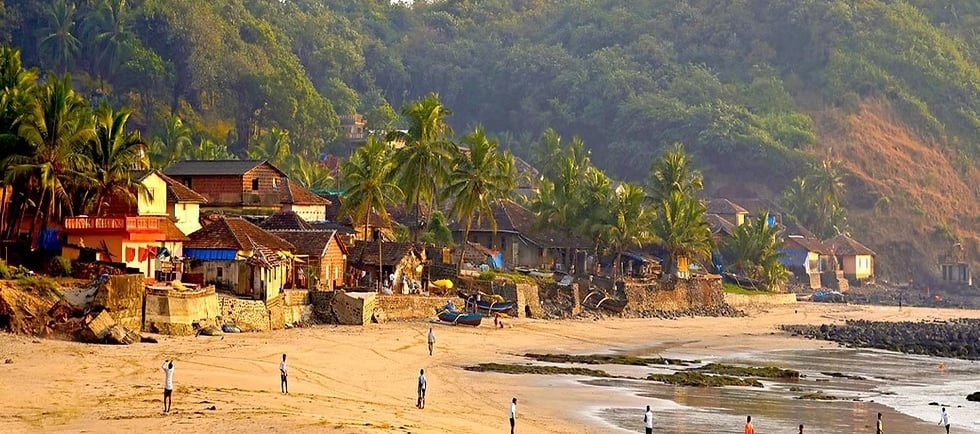Guhagar
Blog post description.
3/18/20253 min read


श्री दुर्गादेवीचे मंदिर व देवीचा खांब
गुहागर, जि. रत्नागिरी
संकलन - सुधीर लिमये पेण
आमच्या गुहागरला निसर्गाने भरभरून दिलेलं आहे. गुहागरचे तसे तीन भाग आहेत. वरचा पाट, मधला किंवा देव पाट आणि खालचा पाट. खालच्या पाटात प्रसिद्ध व्याडेश्वर मंदिर आहे. व्याडेश्वर हे अनेकांचे कुलदैवत असल्याने इथे कायम गर्दी असते. वरच्या पाटात श्री दुर्गादेवीचं मंदिर आहे. तिथेही भाविकांची सतत वर्दळ असते. दुर्गादेवी जिथे अवतीर्ण झाली त्या जागेवर एक खांब बांधलेला आहे. खांबावर देवतांच्या प्रतिमा कोरलेल्या आहेत. या खांबाच्या ठिकाणी देवीचा मूळ वास आहे. इथेच देवी प्रकट झाली. याला देवीचे मूळ स्थान असे न म्हणता देवीचा खांब असेच म्हटले जाते.
पूर्वीच्या काळी गुहागर आणि आसपासच्या समुद्रकिनाऱ्यावरच्या गावांना समुद्री चाचांचा खूप उपद्रव होत असे. हा उपद्रव नाहीसा करण्यासाठी गावकरी महिषासुरमर्दिनीला शरण गेले. तिने या चाच्यांशी युद्ध करून त्यांना पळवून लावले आणि त्यांच्या त्रासापासून गावाची सुटका केली. युद्ध करून झाल्यानंतर गुहागरच्या दातारांना तिने दृष्टांत दिला की मी अमुक-अमुक ठिकाणी आहे आणि मी असल्याची खूण तिथे ठेवली आहे. दातारांनी त्या ठिकाणी जाऊन पाहिले असता त्यांना रुईच्या झाडाच्या एका पानावर देवीच्या नाकातल्या नथीचा मोती चिकटलेला सापडला. हा मोती आकाराने आपल्या बोटाच्या एका पेराएवढा आहे. आजही तो देवळात जपून ठेवला आहे. नवरात्रात तो भाविकांना दर्शन घेण्यासाठी बाहेर काढला जातो.
हे मंदिर तेराव्या शतकातील आहे. पूर्वी गुहागर आणि देशावर खूप आक्रमणे होत असत. त्यामुळे देवीचे मंदिर तिच्या मूळ ठिकाणापासून खूप आत बांधायचे ठरले. दृष्टांतात देवीने मंदिर घरासारखे दिसावे असे सांगितल्याने मंदिराची रचना बाहेरून घर वाटेल अशी परंतु आतून घुमट आणि गाभारा असेल अशी केली गेली. मंदिरात चार मोठे मोठे खांब आहेत. मंदिराचा अलीकडेच जीर्णोद्धार केला असला तरी हे खांब तसेच ठेवण्यात आले आहेत.
देवी एकटी नसून ते पंचायतन आहे. देवीच्या चारही बाजूनी सूर्य, लक्ष्मीनारायण, शंकर आणि गणपतीची छोटी छोटी मंदिरे आहेत. काही 'शे' वर्षांपूर्वीचा अश्वत्थ वृक्ष (पिंपळ वृक्ष) आजही तिथे बघायला मिळतो. या वृक्षाखाली सूर्यनारायणाचे मंदिर आहे. देवीच्या समोरच डाव्या बाजूला एक मोठं तळं आहे. तळ्याला बाराही महिने पाणी असतं. गुहागरातील सगळीजणं या तळ्यातच पोहायला शिकली आहेत.
देवीची रोज दोन वेळा षोडशोपचारे पूजा केली जाते. दुर्गादेवी सकाळी चि. सौ. कां. असते आणि संध्याकाळी ती कुमारिका असते. सकाळी तिच्या गळ्यात मुहूर्तमणी आणि एक वाटी असलेलं मंगळसूत्र असतं. आणि संध्याकाळी ते काढलं जातं. याविषयी एक आख्यायिका सांगितली जाते. देवी संपूर्ण तयार होऊन तिच्या लग्नाला निघाली असता काही कारणामुळे तिला लग्न घरी पोचायला उशीर झाला आणि मुहूर्ताची वेळ टळून गेली. त्यामुळे ती माघारी परतली. जाताना सवाष्णीच्या वेषात गेलेली ती पुन्हा माघारी आल्यावर कुमारिकेच्या मूळ रूपात परत येते. आजही देवीला सकाळी मणिमंगळसूत्र आणि साडी नेसवून तयार केले जाते. संध्याकाळची पूजा झाल्यावर तिला परकर पोलके नेसवले जाते.
नवरात्रीत देवीला रूपकं लागतात. रुपकं म्हणजे देवीवर संपूर्णपणे चांदीचा मुखवटा आणि आयुधं चढवली जातात. देवीच्या मूळ मुर्तीला कापडाने झाकून त्यावरच मुखवटा आणि तिची सगळी आयुधं लावली जातात. दिवसा आणि रात्री दोन्ही वेळा रोज नवीन साडी नेसवली जाते. डोळ्यात साठवून ठेवावे असे तिचे रूप दिसते. नवरात्रात नऊ दिवस रोज संध्याकाळी कीर्तन केले जाते. देवळातील कीर्तनकाराची गादी ही संत तुकारामांची गादी आहे. कीर्तन ऐकायला देवी येते अशी श्रद्धा आहे. त्यामुळे कीर्तनकाराच्या समोरच देवीची बसण्याची सोय केली जाते. देवीला बसण्यासाठी जो गालिचा आहे तो १६८७ सालातला आहे. या गालिच्यावर त्या काळी सोन्याच्या तारांनी जो मोर विणलेला आहे तो आजही जसाच्या तसा आहे. आताच्या काळात प्रसिद्ध असलेली 3D कलाकुसर यावर आहे. मोर जिवंत असल्याचा भास होतो. जवळ जवळ साडेतीनशे वर्षांपूर्वीची ती कलाकुसर आजही उत्तम स्थितीत अस्तित्वात आहे. या गालीचावर कीर्तन ऐकण्यासाठी देवी विराजमान होते. तिच्याकरिता गालिच्याच्या शेजारी चांदीचा नारळ आणि पानसुपारीचे चांदीचे तबक ठेवले जाते.
देवीला दोन बहिणी सुद्धा आहेत. पहिली, बुधल गावाची देवी जी काळ्या पाषाणात आहे, दुसरी दापोली मुरुड येथील देवी जी संगमरवरी दगडात कोरलेली आहे. आणि तिसरी गुहागराची दुर्गादेवी जी गंडकी दगडात कोरलेली आहे. नवरात्रात देवीचा गोंधळ घातला जातो. या गोंधळाला येण्याचे आवाहन देवीच्या दोन्ही बहिणींना केले जाते. मातीच्या सुगडात नारळाच्या कवट्या, सालं, गायीच्या शेण्या घालून त्यात तुपात भिजवलेल्या वाती घालून पेटवले जाते. त्यात ओल्या नारळाच्या चकत्याही टाकल्या जातात. नंतर या चकत्या प्रसाद म्हणून वाटतात. "अगड्या लो रे बगड्या लो बुधलची देवी गोंधळाला येवो" अशाप्रकारचे ते आवाहन असते.
आजही वरच्या पाटात पत्ता सांगायचा झाला तर देवीचा खांब हे परिमाण आहे. देवीच्या खांबापासून चौथी कवाडी. कवाडी ? गम्मत वाटली ना ऐकून. इथे खांबापासून चौथं घर असं न सांगता चौथी 'कवाडी' असंच सांगतात. माझं अख्खं बालपण इथेच गेलं. कधी कधी काहीतरी ट्रिगर होतं आणि या आठवणी उफाळून येतात.
देवीच्या खांबाच्या बरोबर समोरून पुळणीकडे (समुद्राकडे) जाणारा रस्ता आहे. त्याला पायंडी म्हणतात. हा रस्ता भाविकांसाठी आहे. गुहागरकर आपापल्या नारळा-पोफळीच्या वाड्यातून समुद्रावर जातात.
दुर्गादेवीबद्दल मी थोडंसं लिहायचा प्रयत्न केला आहे. तुम्ही सर्वांनी आवर्जून एकदातरी देवळाला भेट द्या. देवळात जाताना खांबाचे दर्शन जरूर घ्या.
Shri Durgadevi Temple and the Sacred Pillar
Guhagar, Dist. Ratnagiri
Compiled by: Sudhir Limaye, Pen
Our hometown Guhagar is abundantly blessed by nature. The town is divided into three regions: Upper Pat, Middle/Deo Pat, and Lower Pat. In the Lower Pat lies the famous Vyadeshwar Temple, a major Kuldaivat (family deity) for many, drawing large crowds. On the Upper Pat, there is the revered Shri Durgadevi Temple, which also sees a steady stream of devotees.
At the very spot where Goddess Durgadevi manifested, a sacred pillar has been erected. The pillar is engraved with images of deities. This spot is believed to be the original seat of the goddess, and instead of calling it her main temple, it is fondly referred to as “Devi's Pillar” (Devi-cha Khamb).
Mythology Behind the Manifestation
In the past, coastal villages around Guhagar were frequently attacked by sea pirates. To protect themselves, the villagers prayed to Mahishasuramardini (a fierce form of Durga). The goddess fought off the pirates, rescued the villagers, and later appeared in a vision to the Datar family of Guhagar, informing them of her presence at a particular location, leaving a sign.
When the Datars visited the spot, they found a pearl from the goddess’ nose ring stuck to a leaf of a Rui (Calotropis) tree. The pearl is about the size of a fingertip and is still preserved at the temple. It is displayed to devotees during Navratri.
Architecture & Significance
The temple dates back to the 13th century. Due to constant invasions, it was decided to build the temple well inside from its original location. As per the goddess’s divine message, the temple was constructed to look like a simple house from the outside, while inside it has a dome and a sanctum (garbhagriha).
The temple features four large pillars, which have been preserved even through recent renovations.
The temple is part of a Panchayatan setup, with small shrines around the goddess for Surya, Lakshmi-Narayan, Shiva, and Ganesha. A centuries-old Peepal tree still stands here, under which there’s a shrine dedicated to Suryanarayan. In front of the temple lies a large pond that holds water year-round—many locals learned to swim here.
Daily Rituals & Symbolism
The goddess is worshipped twice daily with Shodashopachara puja. Interestingly, in the morning, she is dressed as a married woman, and by evening she is reverted to her original maiden form.
There is a tale behind this:
The goddess was fully adorned and ready for her wedding, but due to a delay in reaching the venue, the auspicious time (muhurt) passed, and she returned. She had left as a bride but returned as a maiden.
Thus, in the morning, she is adorned with a Mangalsutra with a pearl pendant, and in the evening, it is removed and she is dressed in a traditional frock-blouse (parkar-polke).
Navratri Festivities
During Navratri, the goddess is decorated with a silver mask and weapons (called "Rupak"). The main idol is covered with cloth, and the decorative silver pieces are placed on top.
Each day, she is dressed in a new saree, day and night.
Daily evening kirtans (devotional performances) are held.
The temple's kirtankar (devotional singer) lineage traces back to Saint Tukaram.
It is believed that the goddess herself attends these kirtans, so a place is arranged for her to sit.
There is a carpet (galicha) placed for her, woven in 1687, featuring a golden peacock that still appears lifelike—much like modern 3D art. It’s over 350 years old and remains in great condition. A silver coconut and a silver betel leaf plate are also placed next to her seat.
Her Sisters and Guhagar Traditions
Durgadevi has two sisters:
Budhal Devi – found in Budhal village, carved from black stone.
Murud Devi – located in Dapoli Murud, carved from white marble.
Guhagar’s Durgadevi – carved from Gandaki stone.
During Navratri, a ritual known as Gondhal is performed and both sisters are invited.
In the ritual:
Earthen pots filled with coconut shells, cow dung cakes, and ghee wicks are lit.
Coconut slices are added, which are then distributed as prasadam.
The devotees sing:
“Agadya lo re Bagadya lo, Budhalchi Devi Gondhalala Yevo”
("Come, come Budhal Devi, come join the Gondhal")
Cultural Notes & Personal Memories
Even today, directions in the Upper Pat use the Devi’s Pillar as a landmark. People still say “Fourth house from the Khamb”, not street number or address—such is the cultural significance.
This place shaped my entire childhood. Sometimes, a small memory sparks a flood of nostalgia.
Just opposite the sacred pillar is a footpath called Payandi, leading to the beach, used mostly by locals and devotees.
Conclusion
This humble write-up is my attempt to share a glimpse of Shri Durgadevi’s divine presence. I urge you all to visit the temple at least once. And when you do, don’t forget to first bow to the Devi’s sacred pillar.
Stay
Comfortable rooms are available for your business needs.
Rentals
© 2025. All rights reserved.
